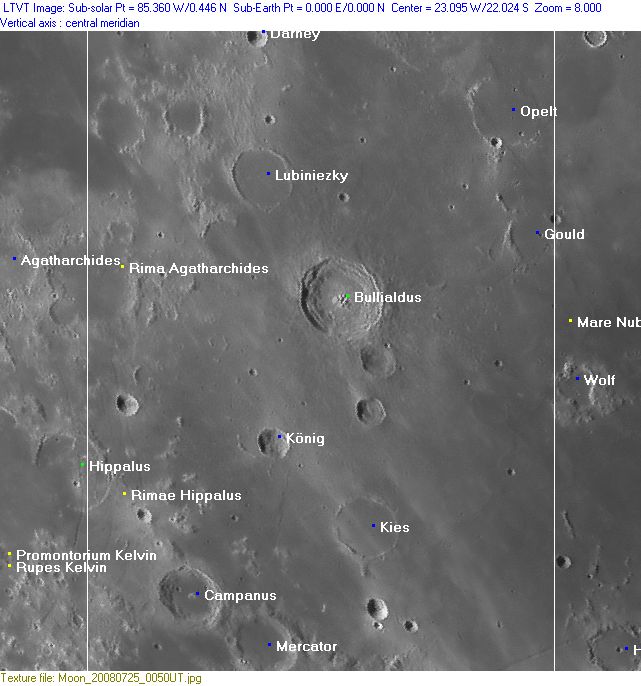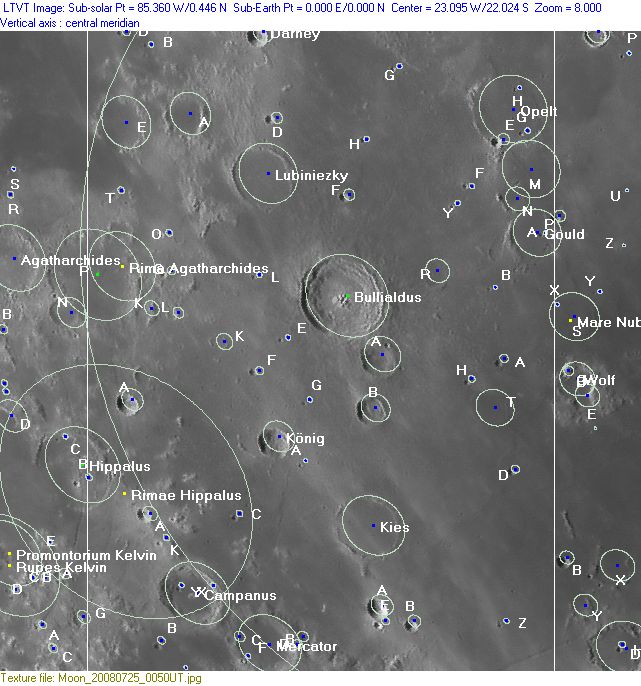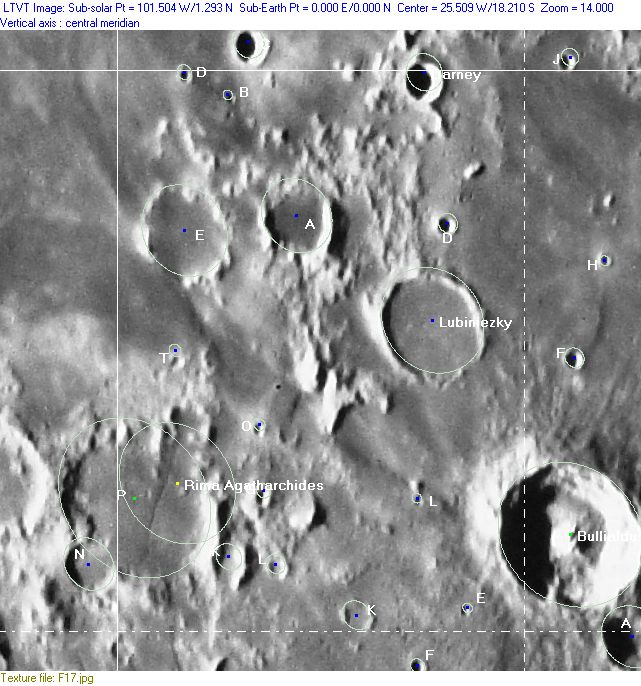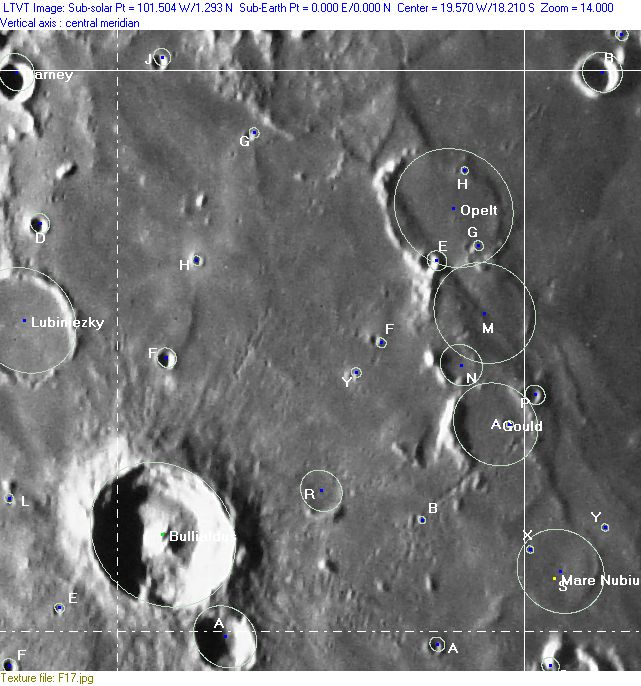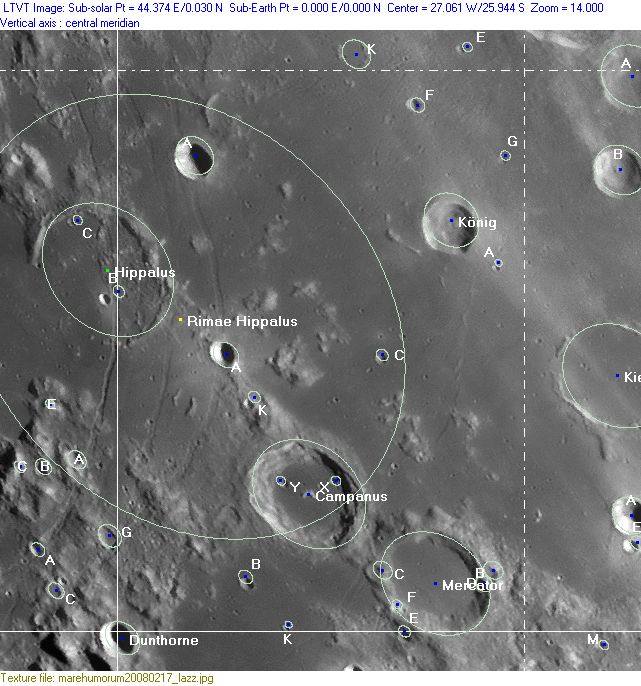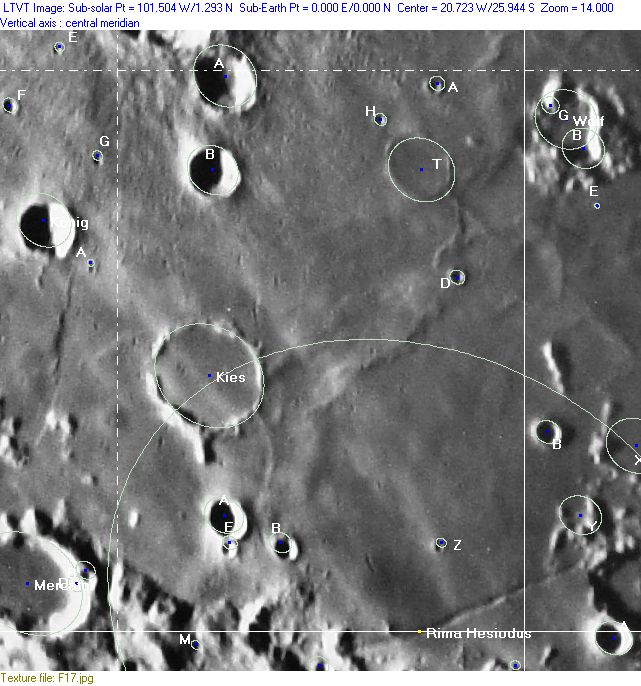Difference between revisions of "Rükl 53"
(Created page with "<div id="content_view" class="wiki" style="display: block"> =Rükl Zone 53 - BULLIALDUS= <br /> Neighboring maps on the [http://the-moon.us/wiki/R%C3%BCkl%20Index%20Map Rü...") |
|||
| Line 2: | Line 2: | ||
=Rükl Zone 53 - BULLIALDUS= | =Rükl Zone 53 - BULLIALDUS= | ||
<br /> Neighboring maps on the [http://the-moon.us/wiki/R%C3%BCkl%20Index%20Map Rükl Nearside Map]:<br /> <div id="toc"> | <br /> Neighboring maps on the [http://the-moon.us/wiki/R%C3%BCkl%20Index%20Map Rükl Nearside Map]:<br /> <div id="toc"> | ||
| − | + | ||
| − | |||
{| class="wiki_table" | {| class="wiki_table" | ||
| | | | ||
| Line 99: | Line 98: | ||
<br /> | <br /> | ||
---- | ---- | ||
| − | + | </div> | |
Revision as of 16:49, 15 April 2018
Contents
Rükl Zone 53 - BULLIALDUS
Neighboring maps on the Rükl Nearside Map:
| 53 |
||
Photographic Map
(This map is based on an Earth-based photograph that has been computer-corrected to zero libration. The vertical white lines indicate the left and right boundaries of the Rükl rectangle)
Background image source
Named Features
- Blue crater (a nickname from D.Caes for the slightly bluish-colored crater Gould P at the northeastern part of Gould's rim).
- Bullialdus (Van Langren's Medicaei, J.Hewelcke's Insula Creta) (note: the central peak of Bullialdus looks kind of yellow on color-enhanced Full Moon photographs).
- Campanus (Van Langren's Gallilaei).
- Campanus Zeta (hill-complex north of Campanus, east of Campanus A) (see Chart 80 in the Times Atlas of the Moon).
- Causeway (a nickname from A.Rukl for the curious causeway at the shallow "valley" Bullialdus W, northwest of Bullialdus itself) (A.Rukl's causeway is mentioned in the heading on page 132 of his atlas).
- Darney (see Clair-Obscur phenomenon at Additional Information below).
- Dorsa Bullialdus W (an unofficial name from D.Caes for the system of wrinkle ridges northwest of Bullialdus, which also contains Harold Hill's Causeway at the shallow elongated depression Bullialdus W).
- Dorsa Darney (an unofficial name from D.Caes for the wrinkle ridges northwest and east of Darney) (see Chart 42 for the northwest wrinkle ridge).
- Dorsa Kies D (an unofficial name from D.Caes for the curved system of wrinkle ridges running across the bowl-shaped crater Kies D, from Kies to the south of the wrinkle-like ghost crater Wolf T).
- Dorsa Lubiniezky E (an unofficial name from D.Caes for the system of wrinkle ridges northwest and south of the almost incomplete crater Lubiniezky E).
- Dorsum Konig (an unofficial name from D.Caes for the wrinkle ridge between Konig and the Golubiz Cluster).
- Golubiz cluster (an informal name for the small cluster of hillocks between Campanus and Kies, called Golubiz cluster on the Rand McNally moonmap).
- Gould
- Hevelii (Van Langren's disallowed name for Lubiniezky A, northwest of Lubiniezky itself).
- Insula Letoa (J.Hewelcke's disallowed name for the nimbus of Campanus A).
- Kies
- Kies Beta (the southern "appendix" of Kies).
- Kies Epsilon (hillock southwest of Kies, west of Kies A).
- Kies Pi (among many observers of the moon, crater Kies is known for the dome Kies Pi west-southwest of it, this dome is one of the most popular lunar surface formations which received a Greek letter designation, unfortunately not recognized by the International Astronomical Union) (why?).
- König
- A hill west-northwest of Konig seems to have been called Phi (see Chart 80 in the Times Atlas of the Moon). Was this Konig Phi or Hippalus Phi?
- Lenham (a disallowed name from H.P.Wilkins for the pronounced bowl shaped crater Kies A, south of Kies itself).
- Lubiniezky
- According to Chart 81 in the Times Atlas of the Moon, there's a hill north-northeast of Lubiniezky called Xi. Is it Lubiniezky Xi or Darney Xi?
- Mare Creticum (J.Hewelcke's disallowed name for a certain region near Bullialdus) (?) (E.A.Whitaker seems uncertain about this).
- Mare Nubium (Van Langren's Mare Borbonicum) (occupying most of Chart 53, for wiki-link see Chart 54).
- Mercator
- Mons Casius (J.Hewelcke's disallowed name for Agatharchides P, called Novellas by H.P.Wilkins) (note: this is the second one of J.Hewelcke's Montes Casius, the first one is crater Vieta on Chart 51).
- Moore (a disallowed name from H.P.Wilkins for the pronounced bowl shaped crater Agatharchides A).
- Opelt (once called Keeler by J.N.Krieger).
- Palus Epidemiarum (Van Langren's Mare de Popoli) (southwest of Campanus and Mercator).
- Rima Agatharchides
- Rima Hesiodus (see SE quadrant map).
- Rimae Hippalus
- Two arcs/ Two-sections-of-a-crater (two nicknames from D.Caes for the incomplete crater at Rimae Hippalus, which looks like two arcs northwest of Campanus) (the same kind of formation is seen at the eastern part of Eddington's floor, see Chart 17, Eddington P).
Lettered Crater Locations
(click on the thumbnails to view full-sized images; use browser BACK button to return to this page)
Full zone with lettered craters
Lettered craters by quadrants
(the dashed white lines are the centerlines of the Rükl zones)
| North West |
North East |
| South West |
South East |
Additional Information
- Other online descriptions of features in this Rükl map section:
Clair-Obscur phenomenon
- When the sunrise-shadow of the small hill north of Darney is running all the way westward toward the bowl-shaped crater Darney C (Lamech's Pierot), then there's a curious small triangle of three illuminated dots between Epimenides and Lacus Timoris (Chart 63, sunrise terminator at 24 degrees west). This Clair-Obscur phenomenon was discovered several years ago by Danny Caes while observing the moon through the restored Cooke-Steinheil refractor of Van Monckhoven, at the Public Observatory in Ghent - Belgium.
